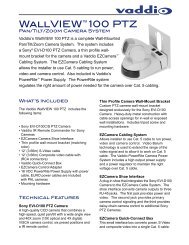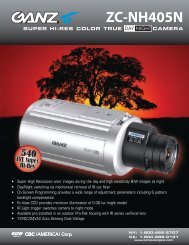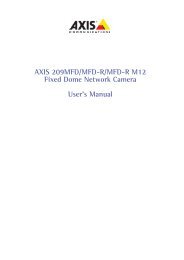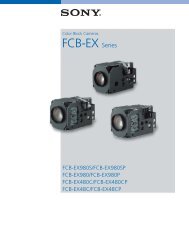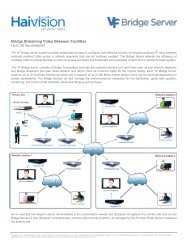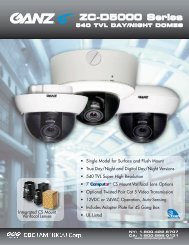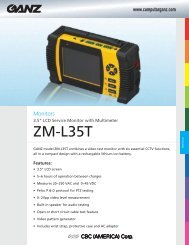AXIS 231D+/232D+ Network Dome Camera User's Manual
AXIS 231D+/232D+ Network Dome Camera User's Manual
AXIS 231D+/232D+ Network Dome Camera User's Manual
You also want an ePaper? Increase the reach of your titles
YUMPU automatically turns print PDFs into web optimized ePapers that Google loves.
62 <strong>AXIS</strong> <strong>231D+</strong>/<strong>232D+</strong> - Glossary of TermsHTML (Hypertext Markup Language) - HTML is the set of"markup" symbols or codes inserted in a file intended fordisplay in web browser. The markup tells the browser howto display the page's words and images for the user.HTTP (Hypertext Transfer Protocol) - HTTP is the set ofrules for exchanging files (text, graphic images, sound,video, and other multimedia files) on the web. The HTTPprotocol runs on top of the TCP/IP suite of protocols.Hub - A (network) hub is used to connect multiple devicesto the network. The hub transmits all data to all devicesconnected to it, whereas a switch will only transmit the datato the device it is specifically intended for.IEEE 802.11 - A family of standards for wireless LANs. The802.11 standard supports 1 or 2 Mbit/s transmission on the2.4 GHz band. IEEE 802.11b specifies an 11 Mbit/s data rateon the 2.4 GHz band, while 802.11a allows up to 54 Mbit/son the 5 GHz band.Image compression - Image compression minimizes the filesize (in bytes) of an image. Two of the most commoncompressed image formats are JPEG and GIF.Interlacing - Interlaced video is video captured at 50pictures (known as fields) per second, of which every 2consecutive fields (at half height) are then combined into 1frame. Interlacing was developed many years ago for theanalog TV world and is still used widely today. It providesgood results when viewing motion in standard TV pictures,although there is always some degree of distortion in theimage.To view interlaced video on e.g. a computer monitor, thevideo must first be de-interlaced, to produce progressivevideo, which consists of complete images, one after theother, at 25 frames per second. See also Progressive scan.IP (Internet Protocol) - The Internet Protocol is a methodtransmitting data over a network. Data to be sent is dividedinto individual and completely independent "packets". Eachcomputer (or host) on the Internet has at least one addressthat uniquely identifies it from all others, and each datapacket contains both the sender's address and the receiver'saddress.The Internet Protocol ensures that the data packets all arriveat the intended address. As IP is a connectionless protocol,which means that there is no established connectionbetween the communication end-points, packets can be sentvia different routes and do not need to arrive at thedestination in the correct order.Once the data packets have arrived at the correctdestination, another protocol - Transmission ControlProtocol (TCP) - puts them in the right order. See also TCP.IP Address - An IP address is simply an address on an IPnetwork used by a computer/device connected to thatnetwork. IP addresses allow all the connectedcomputers/devices to find each other and to pass data backand forth.To avoid conflicts, each IP address on any given networkmust be unique. An IP address can be assigned as fixed, sothat it does not change, or it can be assigned dynamically(and automatically) by DHCP.An IP address consists of four groups (or quads) of decimaldigits separated by periods, e.g. 130.5.5.25. Different partsof the address represent different things. Some part willrepresent the network number or address, and some otherpart will represent the local machine address.See also IP (Internet Protocol).Infrared (IR) - Infrared radiation is radiation at a longerwavelength than visible light, which means it cannot beseen by the naked human eye. As infrared radiation can bedetected as heat, this can be shown on a screen or capturedby a digital camera, with hotter objects showing up brighteragainst colder surroundings (e.g. a human body against acolder background).As color cameras can "see" infrared radiation as well asvisible light, these cameras are equipped with an IR-cutfilter, to prevent distortion of the colors the human eye cansee. To use the camera in very dark locations or at night,this filter can be removed, to allow infrared radiation to hitthe image sensor and thus produce images.An infrared lamp can be used for improved illumination fornight surveillance, whilst not producing any extra visiblelight.Inputs/Outputs (I/Os) - The digital I/Os on, for example, anetwork camera can be used to connect any device that cantoggle between an open and a closed circuit.If, for example, a door switch is used as an input device,opening the door could trigger the upload of video imagesand the sending of notification messages.An output might, for example, be used to automaticallystart a siren when there is a motion detection trigger.I-VOP - See VOP.JPEG (Joint Photographic Experts Group) - Together withthe GIF file format, JPEG is an image file type commonlyused on the web. A JPEG image is a bitmap, and usually hasthe file suffix '.jpg' or ".jpeg." When creating a JPEG image,it is possible to configure the level of compression to use. Asthe lowest compression (i.e. the highest quality) results inthe largest file, there is a trade-off between image qualityand file size.kbit/s (kilobits per second) - A measure of the bit rate, i.e.the rate at which bits are passing a given point. See also Bitrate.LAN (Local Area <strong>Network</strong>) - A LAN is a group ofcomputers and associated devices that typically sharecommon resources within a limited geographical area.Linux - Linux is an open source operating system withinthe Unix family. Because of its robustness and availability,Linux has won popularity in the open source community



